
Stevia leaf extract fermented with bacteria isolated from banana leaves may kill off pancreatic cancer cells without harming healthy kidney cells, according to scientists at Hiroshima University, Japan. This cancer is a highly malignant tumor with a poor prognosis.
The researchers note that the fermented stevia leaf extract showed “significantly enhanced” antioxidant activities and cytotoxicity — the ability to damage or kill cells — against pancreatic cancer cells in the lab. Additional testing demonstrated that the extract effectively inhibited the proliferation and migration of these cancer cells.
“Globally, the incidence and mortality rates of pancreatic cancer continue to rise, with a five-year survival rate of less than 10%,” says co-author Narandalai Danshiitsoodol, associate professor in the university’s Department of Probiotic Science for Preventive Medicine.
“Pancreatic cancer is highly invasive and prone to metastasis, showing significant resistance to existing treatments, such as surgery, radiotherapy, and chemotherapy. As such, there is an urgent need to identify new and effective anticancer compounds, particularly those derived from medicinal plants.”
Earlier studies by different researchers indicated stevia leaf extract’s anticancer potential. However, isolating and applying the specific bioactive components that protect against cancer cells is challenging. Fermenting the extract with bacteria can structurally change the extract and produce bioactive metabolites that can impact living organisms.
“To enhance the pharmacological efficacy of natural plant extracts, microbial biotransformation has emerged as an effective strategy,” says corresponding author Masanori Sugiyama, professor in the Department of Probiotic Science for Preventive Medicine.
His lab has isolated and validated the health benefits of over 1,300 lactic acid bacteria (LAB) strains from various fruits, vegetables, flowers, and medicinal plants.
“In this study, we aimed to compare LAB-fermented and non-fermented extracts to identify key compounds that enhance bioactivity, ultimately contributing to the efficacy of herbal medicine in cancer prevention and therapy.”
The researchers note that fermentation enhanced the extract’s bioactivity, as it showed greater cytotoxicity than non-fermented extracts.The researchers fermented extracts using the plant-derived Lactobacillus plantarum SN13T strain for their study, which was published in the International Journal of Molecular Sciences. They compared the fermented extract’s effects on pancreatic cancer cells and non-cancerous human embryonic kidney cells (HEK-293) to those of non-fermented stevia leaf extract in the lab.
“Our findings indicate that L. plantarum SN13T demonstrates significantly greater cytotoxicity than the non-fermented extract at equivalent concentrations, suggesting that the fermentation process enhances the bioactivity of the extract,” says Sugiyama. “Notably, L. plantarum SN13T exhibited lower toxicity toward the HEK-293 cells, with minimal inhibition observed even at the highest concentration tested.”
In additional analyses, the researchers identified chlorogenic acid methyl ester (CAME) as the active anticancer compound in the solution. Their findings indicate that CAME has cytotoxic effects on the cancer cells by inhibiting cell proliferation and migration, stopping the cell cycle, and regulating gene expression related to apoptosis — cell death.
When the extract is fermented, its concentration of chlorogenic acid drops sixfold. The researchers note this indicates a microbial transformation.
“This microbial transformation was likely due to specific enzymes in the bacteria strain used,” notes Danshiitsoodol. “Our data demonstrate that CAME exhibits stronger toxicity to cells and pro-apoptotic effects — which encourage cell death — on pancreatic cancer cells compared to chlorogenic acid alone.”
The team plans to examine the extract’s effects in a mouse model to determine the effectiveness of various dosages across a whole-body system.
 Stevia leaf extract, as a natural, no-calorie sweetener, is used to meet consumer demand for reduced-sugar food and drink options.“The present study has substantially enhanced our understanding of the mechanism of action of the L. plantarum SN13T strain in the fermentation of herbal extracts, while also offering a valuable research perspective on the potential application of probiotics as natural anti-tumor agents,” says Danshiitsoodol.
Stevia leaf extract, as a natural, no-calorie sweetener, is used to meet consumer demand for reduced-sugar food and drink options.“The present study has substantially enhanced our understanding of the mechanism of action of the L. plantarum SN13T strain in the fermentation of herbal extracts, while also offering a valuable research perspective on the potential application of probiotics as natural anti-tumor agents,” says Danshiitsoodol.
Consumers increasingly seek healthier, low-calorie food options with great taste. Stevia leaf extract, a natural, no-calorie sweetener that is sweeter than sugar, enables food manufacturers to meet these consumer demands.
Earlier this month, Nutrition Insight discussed the rise of sugar reduction with the CEO of PureCircle, Ingredion’s portfolio for stevia flavor modifiers and sweeteners.
Nate Yates told us that stevia will “continue to play a major role” in the space, pointing to Ingredion’s proprietary research that North American consumers are more accepting of stevia than artificial sweeteners.
Meanwhile, research by stevia supplier Cargill indicated that stevia-sweetened beverages and water did not impact blood glucose levels, while beverages with sucrose, glucose, and maltodextrin did. Participants consuming the stevia beverages also consumed fewer calories at a subsequent meal.

Sleep can feel elusive sometimes. Stress, poor sleep hygiene—like not having a healthy bedtime routine—and even medications can interfere with sleep quality and quantity. If you struggle with getting enough quality sleep, you’re not alone. About 12% of Americans have been diagnosed with insomnia.
Defined as trouble falling asleep, staying asleep or getting good quality sleep, insomnia can be short-term or chronic. Besides causing exhaustion and daytime sleepiness, chronic insomnia can also affect memory and concentration, as well as increase the risk of heart disease, high blood pressure, diabetes and cancer.
Healthy sleep habits and cognitive behavioral therapy (CBT) can be effective treatments for insomnia. CBT can help calm the nervous system and prepare it for sleep. Healthy sleep habits include things like creating a healthy sleep environment, avoiding alcohol or caffeine near bedtime and maintaining a consistent sleep routine.
Of course, there are also sleep medications, but they can have unwanted side effects. In an attempt to find drug-free interventions, there is evidence that suggests that exercise may act as a sleep aid. Researchers from China wanted to take a closer look at this possibility and examine more specifically what types of exercise may be most effective. They conducted a systematic review and meta-analysis and published their findings in BMJ Evidence-Based Medicine.
This was a systematic review and meta-analysis, so researchers searched for previously conducted studies that met their criteria. This included studies using participants with insomnia diagnoses and organized exercise as an intervention. After initially finding almost 10,500 studies that met their criteria, researchers rigorously weeded out those that didn’t meet all their standards. They settled on 22 randomized controlled trials, which is considered the gold standard in evaluating cause-and-effect relationships between factors.
The total number of participants included in all 22 studies was 1,348. The exercise interventions included yoga, tai chi, walking or jogging, aerobic/cardio exercise plus strength training, strength training alone, aerobic exercise combined with therapy (i.e. CBT) and mixed aerobic exercises.
RCTs analyze the data in the studies, including running statistical analyses. In this study, many different criteria were tested, based on various aspects of sleep. These researchers concluded that:
Though researchers used rigorous standards when choosing the studies to include in this meta-analysis, there are still a few limitations. First, some of the studies tested at moderate or high levels regarding bias. There was also an absence of exercise “dose”—including frequency and intensity—in some of the studies, so researchers are unable to say how much and at what intensities these exercise types may be most helpful.
If you’re having sleep issues, one of the first things to consider is your sleep hygiene. What does your bedtime routine look like? Ideally, you want to spend an hour before your head hits the pillow preparing your body for sleep. This includes getting off devices, dimming the lights and engaging in relaxing activities, like reading, journaling or listening to calming music. Having a bedtime routine that feels familiar is a healthy trigger for your brain to start preparing for sleep. That routine may be as simple as washing up, flossing and brushing your teeth and getting into pajamas.
Your sleep environment is key, too. Having a dark room allows your body to produce melatonin, the hormone that signals your body that it’s time to go into sleep mode. It’s also important to have your bedroom on the cool side, as being too warm inhibits sleep, and make sure your pillows, mattress and sheets are comfortable for you. Many people also find that white noise, like a fan or the sound of rain, helps with sleep.
As this study suggests, it’s not just what you do at bedtime that influences sleep; what you do during the day matters, too. Yoga, tai chi, walking and jogging all seem to improve sleep quality and quantity. Even getting outside into natural light during the afternoon may help you sleep better.
But what about the timing of exercise?
Recent research suggests that vigorous exercise done within four hours of bedtime may disrupt sleep quality and length. This research suggests opting for light, relaxing exercise if done in the evening, or making sure your vigorous workouts are reserved for earlier in the day and are no closer than four hours before bedtime.
It’s also important to avoid caffeine, nicotine, alcohol and large meals too close to bedtime, and try to keep a consistent bedtime, even on the weekends. If you nap in the afternoon, limit its length if you find it prevents you from falling asleep at bedtime. And if you find you get up at night to pee, take a break from the fluids earlier in the evening.
While eating a large meal too close to bedtime can interrupt sleep, a rumbling belly sure doesn’t help either. If you’re hungry before bedtime, choose a sleep-friendly snack. Some ideas include banana with almond butter, Greek yogurt with sprouted pumpkin seeds and tart cherries or a turkey and apple roll-up.
This systematic review and meta-analysis suggests that yoga, tai chi, walking and jogging may help you sleep better. While this study can’t say how much or at what intensity of each activity helps the most, you can experiment with that. The important thing is that whichever activities you choose, do them consistently over a long period of time for the greatest benefits.

Staying healthy in your 50s, 60s and 70s means adapting to wear and tear, but also embracing all the different ways to thrive. By focusing on some common areas – like nutrition, exercise and meaningful connections – you can age well in every decade.
Here’s what you need to know to extend the quality of life in these decades.
Entering midlife, a person’s health needs can begin to change.
Sometimes these changes can be challenging, but there is “plasticity to ageing”, says Nathan LeBrasseur, director of the Mayo Clinic’s Robert and Arlene Kogod Center on Aging, and you do have some control over the process.
What are normal signs of ageing and how does your body change in your 50s? Wear and tear on the body’s cells and molecules increases the risk of ageing-related diseases, says LeBrasseur.
Biological age is a measure of these cellular and molecular changes over time. It captures how old your body appears based on biomarkers, like telomere length, and how well your body is functioning.
Biological age is a better measure of healthspan, or years of generally good health, than chronological age, or how many years you’ve been alive.
Lifestyle factors, like if you smoke or drink, influence how you age – and focusing on your health now will help in the future.
For some, the menopausal transition may begin between the ages of 45 and 55 and is linked to symptoms including hot flashes, mood changes and sleep disturbances. Women may also experience vaginal dryness or decreased sex drive, while men may begin to experience erectile dysfunction.
What health tests should you get regularly in your 50s? To extend your healthy years, take preventive and proactive measures. The American Cancer Society (ACS) recommends an annual skin cancer screening for anyone over 40, and talking to a healthcare provider about colorectal cancer screenings, yearly mammograms, and lung and prostate cancer screenings.
In the UK, the NHS offers a free health check to people aged 40 to 70 without certain pre-existing conditions. It includes blood pressure and cholesterol tests, and checks your risk of health issues like diabetes and stroke. At 50, you’re also eligible for NHS breast, bowel and cervical cancer screenings.
What are the keys to longevity? Heart health is vital, as is being mindful of your nutrition and exercise. A diet rich in plants, whole grains, healthy fats and lean meats can improve your health. A diversity of physical activity – focusing on endurance, cardio, flexibility and balance – is crucial. It’s never too late to start, and what you do over many years will have a long-term impact, says LeBrasseur.
How do I stay healthy in my 50s?
Your 60s are a period of change. For many, this decade is marked by shifting family dynamics with adult children or new health challenges.
What are normal signs of ageing and how does your body change in your 60s? Getting older, and the physical changes that accompany it, vary person to person. “We’re all more vulnerable to things as we get older, but there’s a lot of heterogeneity of health status among older people,” says Jennifer Schrack, director of the Johns Hopkins Center on Aging and Health.
Older adults may walk more slowly because of pain or emerging balance problems, says Schrack, and osteoarthritis symptoms causing discomfort may emerge as well. As the body ages, the immune system weakens and the risk factor for age-related diseases increases since the body takes longer to fight off infection.
Memory tends to change, and forgetfulness is common as you age, explains Dr Angela Sanford, a care provider and associate professor of geriatric medicine at St Louis University. It’s common to see processing speed slow, and for multitasking to become a bigger challenge. If you worry about forgetfulness, a doctor can advise on cognitive screening tests.
In your 60s, sleep may become more disrupted, with studies indicating that 40 to 50% of those over 60 report difficulty sleeping.
What health tests should you get regularly in your 60s? People in their 60s should be mindful to have regular bloodwork done, says Sanford. An annual eye exam, screening for colorectal cancer and diabetes, are also recommended. Women should have mammograms and test bone density, which declines during menopause.
What are the keys to longevity? Genetics, lifestyle choices and environment are the factors that most affect your health, says Schrack.
after newsletter promotion
Regular appointments with a healthcare provider benefit all older people, Schrack says, and preventive care can improve longevity. Mobility and staying active contribute to quality of life as does maintaining positive relationships.
How do I stay health in my 60s?
Today’s septuagenarians are different. “Many transitions that are happening now at 70 are the types of transitions people in previous generations might have experienced in their early 60s,” says Jeffrey Stokes, an associate professor at the University of Massachusetts Boston who studies ageing. People in this age group now have longer life expectancy, and are also becoming grandparents and retiring later than previous generations.
What are normal signs of ageing and how does your body change in your 70s? Some medical conditions and functional problems, like decreased mobility and impaired balance, become more common as people age, according to Dr Mark Lachs, chief of geriatrics and palliative medicine at Weill Cornell Medicine.
However, lifestyle factors play a role, and how much you feel these changes will be very individualized. And while there is no one “normal” way to age, it is common to experience health challenges like arthritis, hypertension or increased trouble sleeping.
In comparison to earlier decades, your 70s can be quite stable – especially for women who have already experienced menopause.
What health tests should you get regularly in your 70s? Many recommended screenings are framed as guidelines for those above 65 in the US and UK. This reflects a lack of research and that screenings become more complicated as we age, says Dr Deborah Kado, a professor of medicine and co-director of the Stanford Longevity Center. It can be difficult to provide general recommendations because individual needs at this stage can vary.
Some screenings to consider are for bone mineral density and functional limitations (to see, if for example, you are at risk for falling), according to Dr Mark Lachs, chief of geriatrics and palliative medicine at Weill Cornell Medicine.
What are the keys to longevity? Movement is important, says Lachs, and any kind of cardiovascular exercise at modest levels will help. Relationships, both casual and close, can improve a person’s health and sense of purpose, says Stokes.
While many people in their 70s will have deep, meaningful relationships – like those with children and grandchildren – there’s often less emphasis on fostering new connections. Targeting this can help improve the loneliness and isolation faced by many in their oldest years, says Stokes.
Adequate sleep – at least seven to nine hours each night – and a diet that contains less meat and more plans can contribute to overall longevity, too.
How do I stay healthy in my 70s?
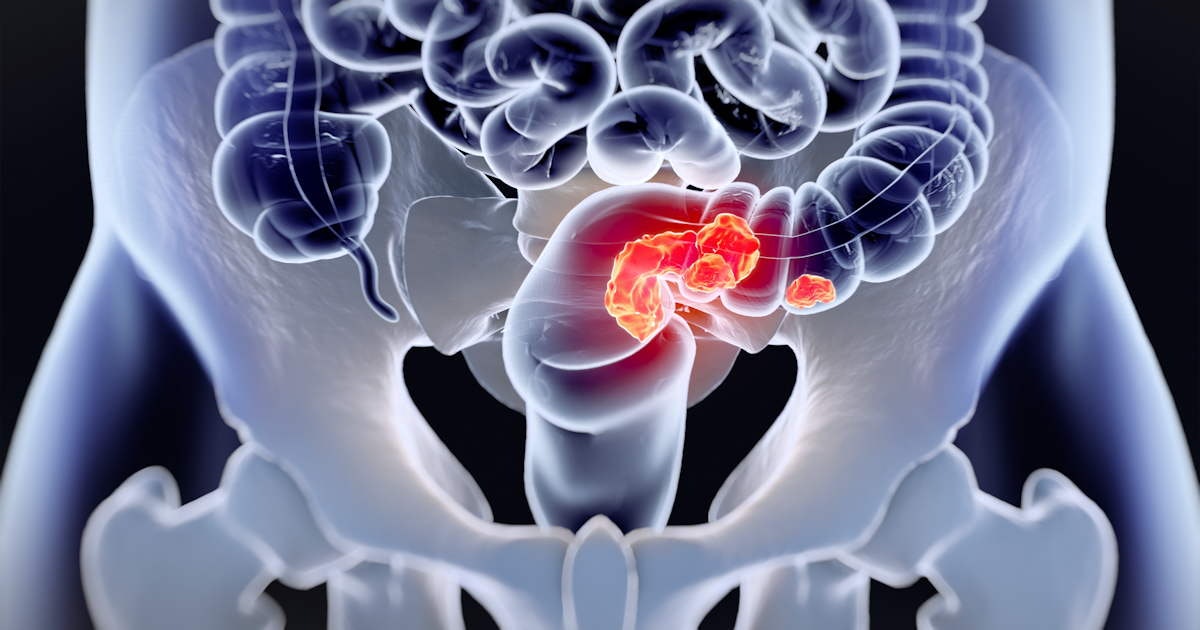
Efforts to expand CT colonography (CTC) screening in the U.S. could use deliberate measures to establish dedicated centers and prevent uneven performance or inconsistent patient management during initial rollouts, say researchers reporting 20-year programmatic results.
The team led by Perry Pickhardt, MD, from the University of Wisconsin School of Medicine and Public Health in Madison, analyzed data from nearly 12,000 patients and over 15,000 colorectal cancer screening (CRC) examinations performed there between April 2004 and March 2024. Their summary, correlation with subsequent optical colonoscopy findings, and benchmarks were published July 23 in the American Journal of Roentgenology (AJR).
First, the findings support CTC screening as a safe, noninvasive test for CRC prevention and detection with additional extracolonic assessment, according to the group.
Furthermore, distributions of C-RADS colorectal and extracolonic categories, positive predictive values, and most frequent histologic results may provide benchmarks for practices seeking to establish a center of excellence for CTC screening, added Pickhardt and colleagues Max Golden, MD, and David Kim, MD.
Notably, the screening-focused CTC program adopted a range of measures for standardization and quality assurance. The group described dedicated coordinators handling the intake (including the handling of insurance issues), preparation, initial post-test disposition, and follow-up of patients undergoing CTC examinations.
Additionally, training and performance measures include participating technologists who perform CTC examinations and radiologists, and case results are documented in a comprehensive clinical CTC database.
The radiologists conducted their interpretations using dedicated software (V3D Colon, Viatronix) with a 3D-2D hybrid approach for polyp detection, according to the report.
“These 20-year programmatic results can provide benchmarks for practices seeking to start CTC screening programs,” Pickhardt and colleagues said.
While the team highlighted the potential for boosted CTC utilization rates following a national Medicare reimbursement decision in January 2025, they also acknowledged low utilization and an overall lack of CTC screening uptake.
Annual volume of CTC examinations performed for primary evaluation substantially decreased from a maximum of 1,589 in 2005 to 72 in 2023, with a minimum of 70 in 2020, the group reported.
Likewise, annual volume of examinations performed for asymptomatic screening decreased from a maximum of 1,532 in 2005 to a minimum of 53 in 2023.
Annual volume of initial examinations performed for symptomatic evaluation also decreased, from a maximum of 57 in 2005 to a minimum of 19 in 2023, while the number of exams performed after incomplete optical colonoscopy varied from a minimum of 65 in 2005 to 80 in 2023, with a maximum of 111 in 2008.
“While the study institution has performed relatively large volumes of CTC examinations, CTC has overall played a very small role in CRC screening in the adult U.S. population to date,” Pickhardt and colleagues said.
They cited that stool DNA testing (Cologuard) had a likely prominent impact on CTC volumes in the later portion of the study period, as did a lack of buy-in and awareness from gastroenterologists and other primary care providers, according to the group.
However, “through proper technique, CTC screening can provide noninvasive CRC prevention that is lacking with stool-based tests, avoid the complications associated with primary [optical colonoscopy] screening, and provide the unique additional benefit of extracolonic evaluation,” Pickhardt and team concluded. “Efforts are warranted to address decreasing utilization.”
Read the complete study here.

Computer scientists at the University of Rochester have developed an AI-powered, speech-based screening tool that can help people assess whether they are showing signs of Parkinson’s disease, the fastest growing neurological disability in the world. A study published in the journal npj Parkinson’s Disease introduces a web-based screening test that asks users to recite two pangrams—short sentences using all 26 letters of the alphabet. Within seconds, the AI analyzes the voice recordings for subtle patterns linked to Parkinson’s, with nearly 86 percent accuracy.
Parkinson’s disease is typically diagnosed by movement disorder specialists—neurologists with specific training to evaluate complex motor symptoms—using a combination of family history, neurological examinations, and brain imaging. While the study’s authors emphasize that their AI-based tool is not a substitute for a clinical diagnosis, they see it as a fast, low-barrier, and accessible way to flag people, especially in remote areas, who might be living with the condition and encourage them to seek more thorough clinical evaluations.
“There are huge swaths of the US and across the globe where access to specialized neurological care is limited,” says Ehsan Hoque, a professor in Rochester’s Department of Computer Science and co-director of the Rochester Human-Computer Interaction Laboratory. “With users’ consent, widely used speech-based interfaces like Amazon Alexa or Google Home could potentially help people identify if they need to seek further care.”
To train and validate the tool, the researchers collected data from more than 1,300 participants—with and without Parkinson’s—across diverse environments, including home settings, clinical visits at the University of Rochester Medical Center, and the InMotion Parkinson’s disease care center in Ohio.
Using the computer’s microphone, users simply read aloud two sentences: “The quick brown fox jumps over the lazy dog. The dog wakes up and follows the fox into the forest, but again the quick brown fox jumps over the lazy dog.” By leveraging the power of advanced semi-supervised speech models trained on millions of digital audio recordings to understand the characteristics of speech, the tool can glean enough vocal cues from those two short sentences to flag warning signs.
“These large audio models are trained to understand how speech works; for example, the way someone with Parkinson’s would utter sounds, pause, breathe, and inadvertently add features of unintelligibility is different in someone without Parkinson’s,” says Abdelrahman Abdelkader, a computer science master’s degree student in Hoque’s lab and one of the two lead authors of the study. “If a person is saying the pangram that contains the full spectrum of the alphabetical variability and trails off at certain points, the model can tell if that’s different from the typical representation and flag it.”
The tool was 85.7 percent accurate when tested, providing a strong indication of whether someone may have Parkinson’s. But it is a multifaceted disease, and while some people demonstrate symptoms through speech, they can also display signs through motor tasks or facial expressions. Over the last decade, Hoque’s lab has pursued clever algorithms to combine multiple indicators and produced state-of-the-art results.
“Research shows that nearly 89 percent of people with Parkinson’s have a deformity in their voice that can be indicative of the disease, making speech a strong starting point for digital screening,” says Tariq Adnan, a computer science PhD student affiliated with Hoque’s lab and another lead author of the study. “By combining this method with assessments of other symptoms, we aim to cover the majority of people through our accessible screening process.”
An interactive demo of the lab’s three screening tests, including the speech test outlined in the paper, is available online.
The other authors of the paper include PhD students Md. Saiful Islam, who co-supervised the work with Hoque, Zipei Liu, Ekram Hossain, and Sooyong Park.
The study was funded by the National Institute of Neurological Disorders and Stroke of the National Institutes of Health, the Gordon and Betty Moore Foundation, a Google Faculty Research Award, and a Google PhD Fellowship.
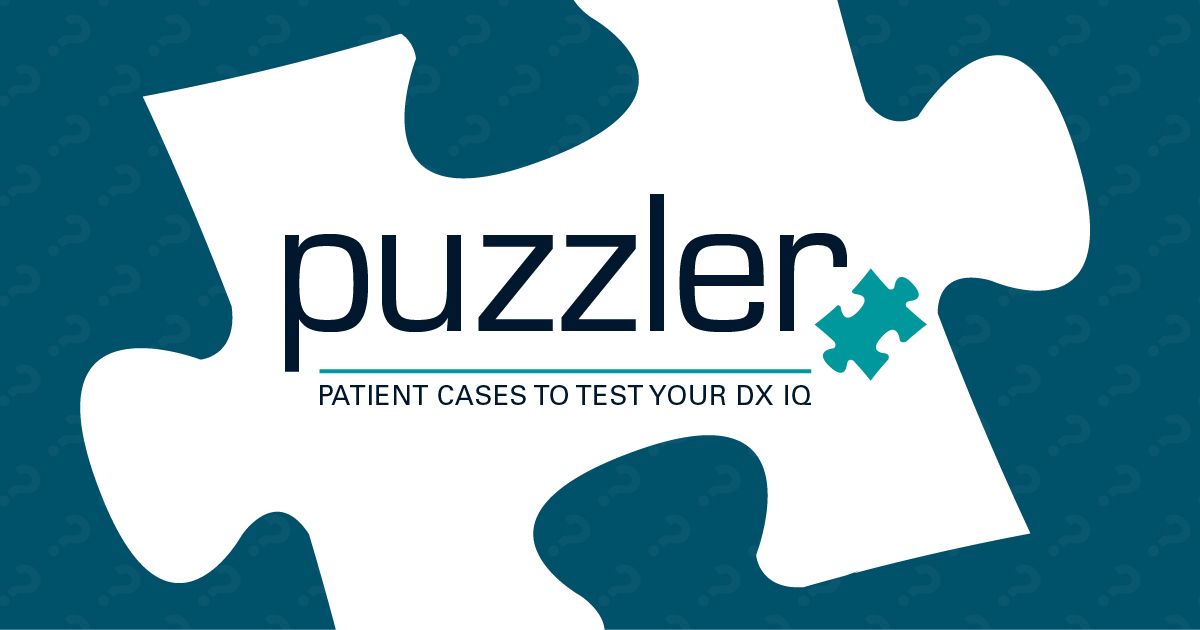
Figure 1:CXR completed on day 5 of admission demonstrates right perihilar and lower lobe opacities.
Click image to zoom in
A 23-month-old female presented with a 3-day history of cough, rhinorrhea, and increased work of breathing. Initially, she was treated for bronchiolitis at an urgent care center, where a nasopharyngeal swab identified adenovirus. Despite initial treatment, the patient’s condition worsened, and she required oxygen supplementation via nasal cannula for oxyhemoglobin desaturation. Her hypoxemia further deteriorated, necessitating an increase in oxygen supplementation (Figure 1).
On physical examination, the patient showed signs of respiratory distress. A chest X-ray (CXR) revealed opacities in the right middle and lower lobes. The patient’s condition improved with supportive care, and she was discharged after several days in the hospital.
However, 9 months later, due to recurrent wheezing, she was referred to the pulmonary service for further evaluation. A follow-up CXR, taken 3 months after the initial infection, demonstrated complete opacification of the right hemithorax with a mediastinal shift to the right, as well as collapse of the right upper and middle lobes.
Figure 2:
CXR 3 months after hospitalization shows complete opacification of the right hemithorax with mediastinal shift to the right.
Click image to zoom in

On physical examination, the patient appeared in mild respiratory distress. Her oxygen saturation was 96% on room air. Breath sounds were diminished on the left side, with crackles noted in the right lower lung fields. Her growth and development were normal, and she was in the 25th percentile for both height and weight. A complete blood count and metabolic panel were within normal limits.
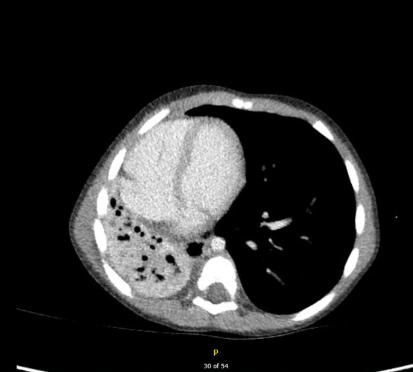
Figure 3: (A) and (B):
Axial and coronal chest CT views 3 months after the patient’s initial infection demonstrate pronounced mediastinal shift with a presumed collapse of the right upper and middle lobes. There is dense airspace consolidation throughout the lower right lobe with superimposed bronchiectasis.
Click image to zoom in
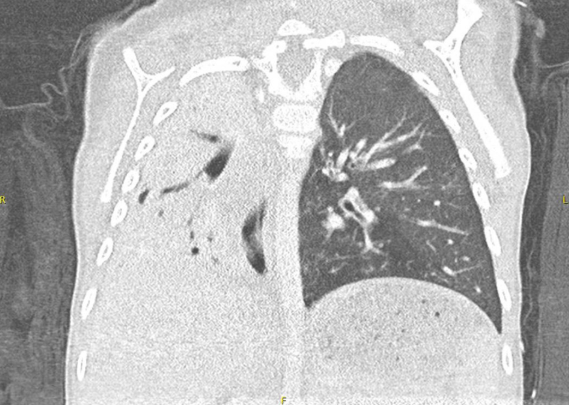
Due to recurrent wheezing, she was referred to the pulmonary service. A follow-up CXR (3 months afterward) showed complete opacification of the right hemithorax with mediastinal shift to the right and collapse of the right upper and middle lobes (Figure 2). CT scan of the chest revealed unilateral hyperlucency of the left lung. There was complete opacification of the right hemithorax, mediastinal shift to the right, and atelectasis of the right upper and middle lobes with superimposed bronchiectasis (Figures 3A and B). Her findings were consistent with Swyer-James-Macleod Syndrome (SJMS) (Table). Her condition was managed with inhaled corticosteroids, chest physiotherapy, and antibiotics during exacerbations. Her most recent CXR, fifteen months after initial presentation, continues to reveal hyperlucency of the left lung (Figure 4).
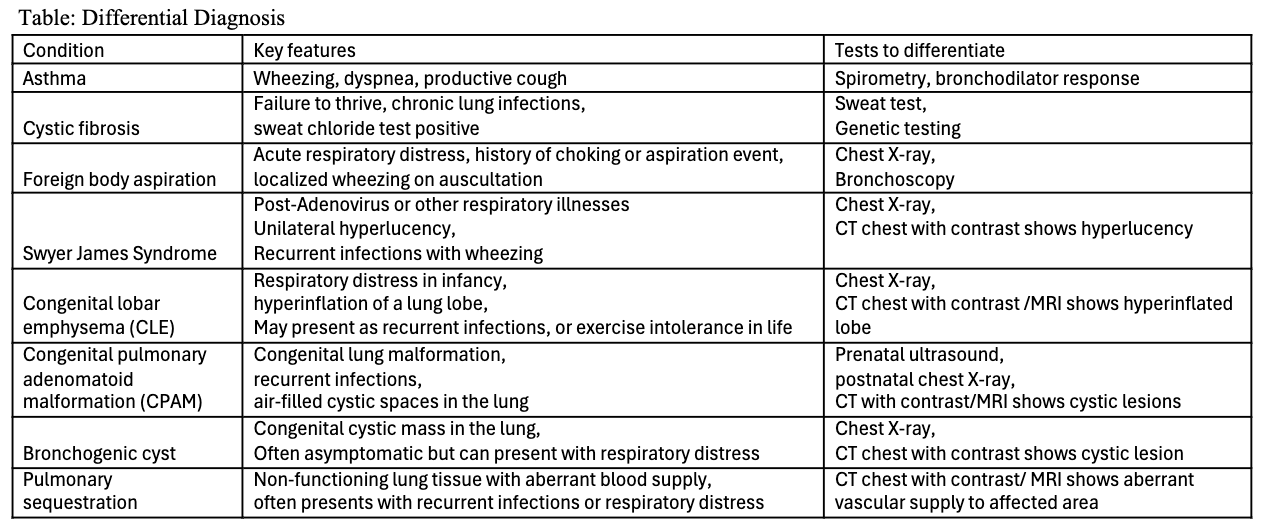
Her condition was managed with inhaled corticosteroids, chest physiotherapy, and antibiotics during exacerbations.
Figure 4:
Follow-up CXR 15 months after initial infection demonstrates hyperlucency of the left lung with collapse of the right lung.
Click image to zoom in

We present a rare case of Swyer-James-Macleod Syndrome (SJMS) in a pediatric patient. SJMS is a post-infectious bronchiolitis first described by Swyer and James in 1953.1-4 This condition is characterized by unilateral hyperlucency of the lung, typically following a viral or bacterial infection in infancy or early childhood. Our patient’s diagnosis followed recurrent respiratory infections and lung collapse.
SJMS can be associated with numerous infections, including adenovirus types 3, 7, and 21, paramyxovirus, Bordetella pertussis, Mycobacteria, Mycoplasma pneumoniae, influenza virus, Streptococcus pneumoniae, and Staphylococcus aureus.1 These infections lead to inflammation and fibrosis that cause bronchial lumen narrowing, reduced ventilation/perfusion, and vasoconstriction, consequently reducing blood flow to the pulmonary artery and leading to arterial hypoplasia.5 In addition, decreased pulmonary vascularization, abnormal alveolar development, and destruction of the pulmonary parenchyma and alveoli are observed.6
Due to its rarity, little is known about the incidence of SJMS, and the clinical course varies based on the presence or absence of bronchiectasis.5 Adults with SJMS are often asymptomatic, with the condition being an incidental finding on imaging. In contrast, children tend to be symptomatic, presenting in infancy or early childhood with dyspnea, wheezing, recurrent respiratory infections, productive cough, failure to thrive, and, rarely, hemoptysis and spontaneous pneumothorax.2,5,6,10
Diagnostic tools such as bronchoalveolar lavage (BAL) have shown active inflammatory processes in SJMS, with increased neutrophils and lymphocytes, specifically CD8+ T cells.8 Pulmonary function tests may reveal mixed obstructive-restrictive ventilation defects.7 Imaging remains key to diagnosis, with chest X-ray and CT scans revealing characteristic findings of unilateral hyperlucency, bronchiectasis, and lung collapse, as seen in our patient.7
In the differential diagnosis of unilateral hyperlucency (Table), conditions such as congenital lobar emphysema (CLE), bronchogenic cyst, CPAM, and pulmonary sequestration must be considered. CLE presents with respiratory distress in infancy and hyperinflation of the lung lobe, whereas SJMS typically follows an infectious process and affects an entire lung. Pulmonary sequestration, involving non-functioning lung tissue with an aberrant blood supply, also needs to be ruled out using imaging studies such as CT or MRI.
Treatment for SJMS is preventative and conservative, with a focus on averting further infection. Management includes airway clearance with chest physiotherapy, vaccinations against influenza and pneumococcal infections, and antibiotic treatment during exacerbations.2,7 The efficacy of surgical interventions, such as lung resection, is not well established but remains an option in cases of clinical pulmonary deterioration, recurrent infections despite prophylactic measures, or recurrent pneumothoraces.8 Further studies are needed to explore the benefits of inhaled medications, including bronchodilators and inhaled corticosteroids with or without long-acting beta-agonists.
This case highlights the importance of recognizing SJMS as a sequela of early childhood respiratory infections. Early diagnosis and intervention can help reduce the long-term risk of complications such as bronchiectasis and progressive lung disease.
References:

A hormone-free male birth control pill passed its first safety test in ongoing clinical trials, marking a major milestone in its development.
The results from the early phase 1 clinical trial testing the safety of the daily pill referred to as YCT-529 were published on Tuesday in the journal Communications Medicine.
The pill is designed to decrease sperm count by impairing retinoic acid signaling in the testes, according to its San Francisco-based developers YourChoice Therapeutics.
RELATED STORY | Male birth control gel shows promising results in clinical trials
The early clinical trial included 16 male volunteers aged 32 to 59, all of whom had undergone a vasectomy. The reason a vasectomy was a requirement for the trial is that the developers wanted the extra precaution to avoid the risk of permanently affecting participants’ fertility, since the drug has not been clinically trialed for effectiveness — just safety.
The volunteers were each given single oral doses of 10mg, 30mg, 90mg or 180mg of YCT-529 after fasting. The participants’ reaction to the medication was studied for safety and potential side effects on heart rate, inflammatory biomarkers, sexual desire and mood.
They also received a 30mg dose after eating to study the effects of the drug mixed with food.
The trial did not assess the pill’s efficacy in reducing sperm, but those trials are ongoing.
Researchers said the study did not find any adverse effects from the drug, signaling promise as it continues its development.

There is a high prevalence of depressive symptoms among woman who are diagnosed with premature ovarian insufficiency (POI), according to recent data published in Menopause.1 The authors of the study said the findings highlight the need for targeted mental health support that addresses the unique needs of this patient population.
Premature Ovarian Insufficiency Associated With Depressive Symptoms / Lightfield Studios – stock.adobe.com
POI is characterized by impaired ovarian follicle function before the age of 40 and affects approximately 3.7% of women worldwide. In addition to fertility challenges, POI increases the long-term risk of bone loss, cardiovascular disease, and cognitive decline. While many cases remain idiopathic, evidence increasingly supports a strong genetic basis, with the age of menopause recognized as a heritable trait. 2
“Women with POI not only experience the symptoms associated with estrogen deficiency but also experience the loss of reproductive function,” the authors wrote. “A combination of these factors may lead to various psychological problems that significantly impact their quality of life.”
Investigators from the Erasmus University Medical Center conducted a study to explore associations between clinical and patient reported variables and depressive symptoms in women with POI. Data for the study was gathered from the university’s Women’s Health Research and Innovation Center.
The study included 345 women with POI who attended the hospital’s multidisciplinary POI care unit between April 2020 and December 2023. Before each hospital visit, the women were asked to complete multiple questionnaires, including the Beck Depression Inventory (BDI-II), the Greene Climacteric scale (GCS), and a questionnaire about general health, medical history and lifestyle. Additionally, a comprehensive patient assessment and personalized health care plan was formulated at the first visit.
The study found that of the 345 women, 103 reported depressive symptoms. Women who were younger at the time of POI diagnosis, lacked emotional support, or had an increase in severe menopausal symptoms were more likely to experience depressive symptoms. The study also found that there was no difference in depressive symptoms between women who used estrogen plus progestogen therapy and those who did not.
Additionally, a subgroup analysis showed that lower fertility related quality of life and limited emotional support were related to depressive symptoms in women who were experiencing fertility-related grief.
“Our findings underscore the high prevalence of depressive symptoms in this population and highlight the importance of comprehensive care addressing both physical and psychological aspects of menopause at an early age,” the authors concluded. “To fully address the mental health needs of women with POI, a multidisciplinary approach is essential, incorporating psychological support, symptom management strategies, and tailored interventions to address the specific challenges faced by this population.”
READ MORE: Women’s Health Resource Center
Ready to impress your pharmacy colleagues with the latest drug information, industry trends, and patient care tips? Sign up today for our free Drug Topics newsletter.
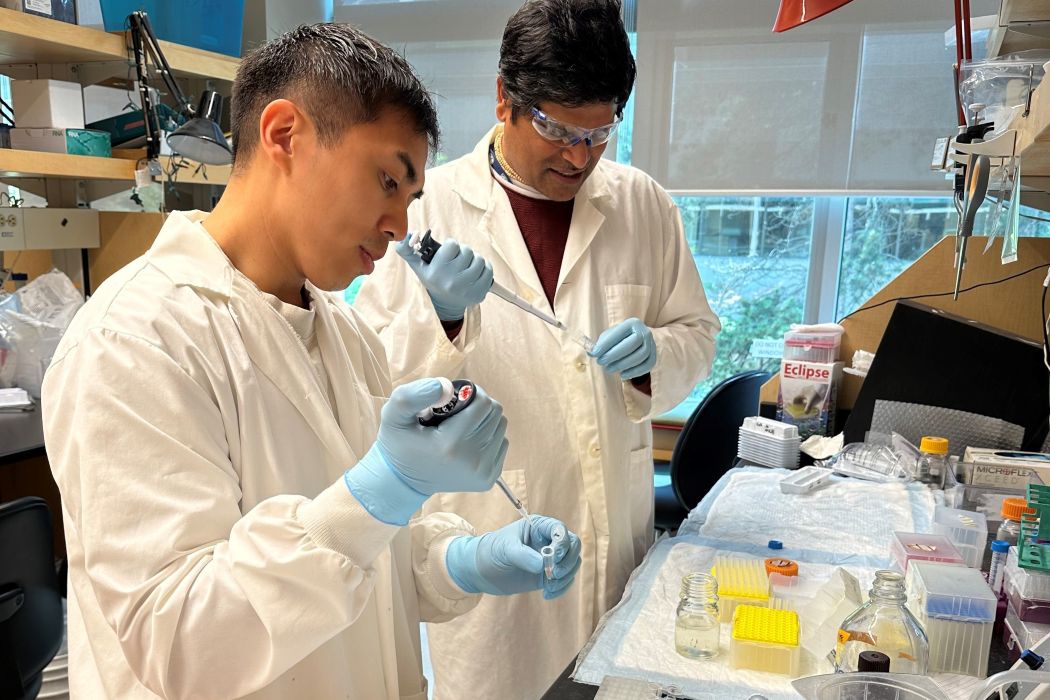
Eyam claims its AI drug discovery and delivery platform can develop treatment at less than half the usual cost.
Vancouver-based Eyam Health has struck a research partnership with Medicines for Malaria Venture (MMV), a Swiss non-profit that helps develop malaria treatments, to discover a more affordable antimalarial solution.
The partnership will use Eyam’s Jennerator platform, which relies on artificial intelligence (AI) to design medications, and its Gemini system (no relation to the Google-owned AI model) to develop and deliver monoclonal antibodies for malaria treatment.
Eyam has received multiple grants from the Bill & Melinda Gates Foundation to develop its Gemini platform.
Monoclonal antibodies are lab-made proteins that help stimulate the immune system to fight disease. Eyam and MMV claim a single, long-acting injection could protect a patient for an entire rainy season, the roughly five month period where peak malaria transmission occurs. Eyam claims its Gemini system enables medications to be delivered without cold storage, while carrying multiple antibodies in a single dose that costs less than one dollar.
According to the World Health Organization (WHO), malaria vaccines can cost between two to four dollars per dose.
Eyam says the Gemini delivery system also makes it possible to target multiple stages of a parasite’s lifecycle, and can be readily adapted for local manufacturing in communities in Africa where malaria is prevalent.
“The approach to develop affordable monoclonal antibodies with longer dosing intervals could be truly transformative for improving delivery and efficacy of broadscale preventive malaria campaigns including potential use in mass administration campaigns to accelerate malaria elimination,” MMV senior director Brice Campo said in a statement.
RELATED: Reverb Therapeutics closes $17-million seed round led by Amplitude Ventures
Founded in 2020 by Vancouver native Dr. Wilfred Jefferies, Eyam uses its Gemini and Jennerator platforms to develop treatments for infectious diseases, cancer, chronic disease, and animal health applications. The company has received multiple grants from the Bill & Melinda Gates Foundation, which has previously committed to funding the eradication of malaria, to develop its Gemini platform.
According to the WHO, there were an estimated 263 million malaria cases in 2023, with 597,000 deaths from the disease, about three-quarters of them among children under five, in 83 countries. MMV launched in 1999 to use the expertise and resources of its partner network to discover, develop, and deliver new malaria treatments. MMV claims that its supported products have treated approximately 711 million people as of 2024.
Feature image courtesy Eyam Health.